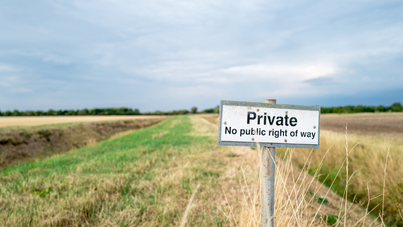Author
This article is one in a series looking at the impact of public rights over land intended for development. In this article, we will focus on how as a landowner you can seek to avoid new public rights being registered or accruing by the use of landowner statements.
Public rights over land can come into existence in a number of ways either by a legal agreement or by long use. For more information, please see our articles on some of these rights Part 1, Part 2 and Part 4. It is worth noting that the rights discussed in these articles are not exhaustive, and there are other ways that public rights can be created over land.
As a landowner how can you avoid new rights being dedicated?
If you are a landowner and you intend to sell your land for development now or in the future, you may want to ensure that no new rights are created over your land. For some practical tips for reviewing and potentially restricting the use of your land please see our article.
Section 31(6) Highways Act 1980
In relation to rights of way specifically, you may be able to prevent new rights from being created by firstly showing that you have taken action to make it clear to the public that there is no right of way over your land. You may do this by installing fences and locked gates, or you may erect signs or notify members of the public verbally that there is no right of way. For further information about the type of information you should include in a notice on your land, please review Section 31(3) and 31(5) of the Highways Act 1980 or take further legal advice.
Another option if you believe that a public right of way may have been created and you wish to ‘fix’ that right to stop any further rights being created, is to submit a landowner statement to the relevant local authority under Section 31(6) of the Highways Act 1980. Section 31(6) allows a landowner to submit a map of the land showing the proposed right of way and a statement indicating what ways (if any) over the land they admit to being a public right of way. Within 20 years of submitting the statement the landowner must then lodge a further declaration confirming that no new rights of way have been dedicated since the original statement. This will then prevent any public use of the land during that period from counting towards the creation of any new rights by long use. However, this process will not prevent a right of way from being created by long use where the relevant period has arisen before the original Section 31(6) statement has been made.
Local authorities maintain a register of landowner statements and maps and you can therefore check with the local authority before submitting an application to see whether a statement has been submitted by a previous landowner.
Section 15A Commons Act 2006
It is also possible for a landowner to submit a statement and map with the ‘commons registration authority’ (generally the relevant local authority) under Section 15A of the Commons Act 2006 to protect their land from registration as a town and village green, as well as protecting the land from further rights of way being established. As with the Section 31(6) application, this stops time running in relation to any use of the land by the public which may lead to the creation of new rights by long use.
Section 15A(2) of the Commons Act notes that the deposit of a landowner statement does not prevent a new period commencing, and therefore if you believe that members of the public are using your land in a way which, if it were to continue for 20 years, could allow them to submit an application to register the land as a town and village green you should take practical steps to stop them doing so. Further information regarding town and village green applications can be found in our article [Part 4].
It is also worth noting that there will be a cost for submitting either of the above applications. At the time of writing this article and by way of example, the cost for submitting a statement under Section 31(6) of the Highways Act 1980 or Section 15A of the Commons Act 2006 was £406 for Cornwall Council and £380 for Devon County Council. You may also wish to seek legal advice before submitting the application, and for advice on what to include within the statement.
This article is for general information only and does not, and is not intended to, amount to legal advice and should not be relied upon as such. If you have any questions relating to your particular circumstances, you should seek independent legal advice.


